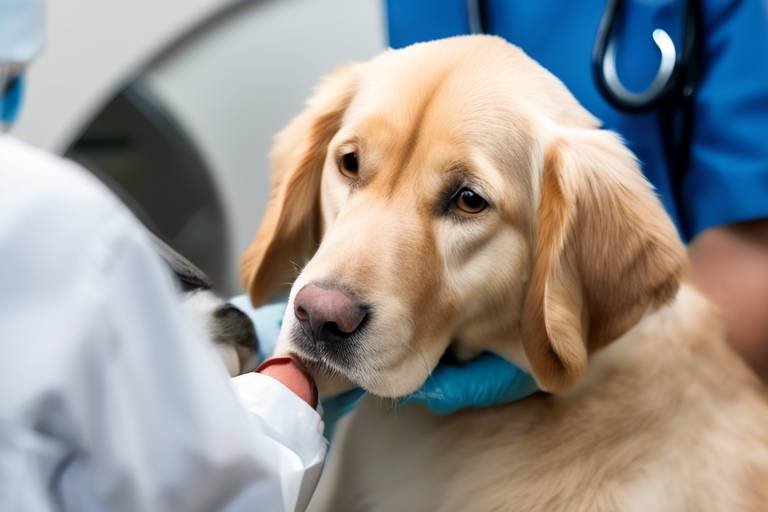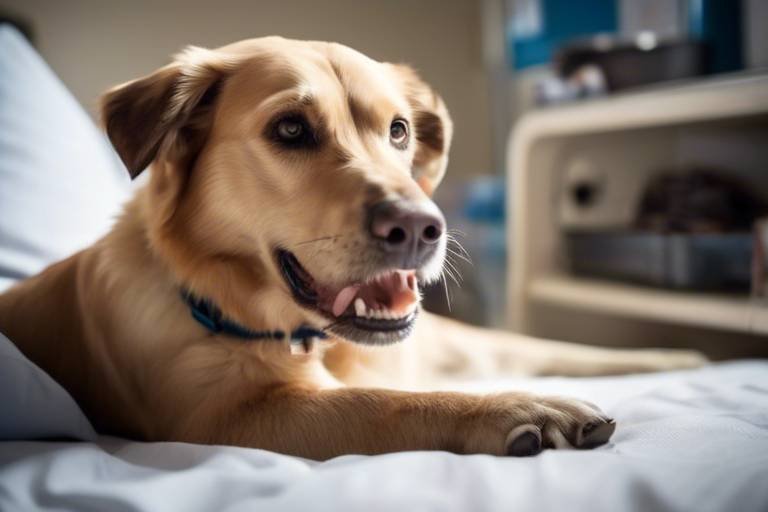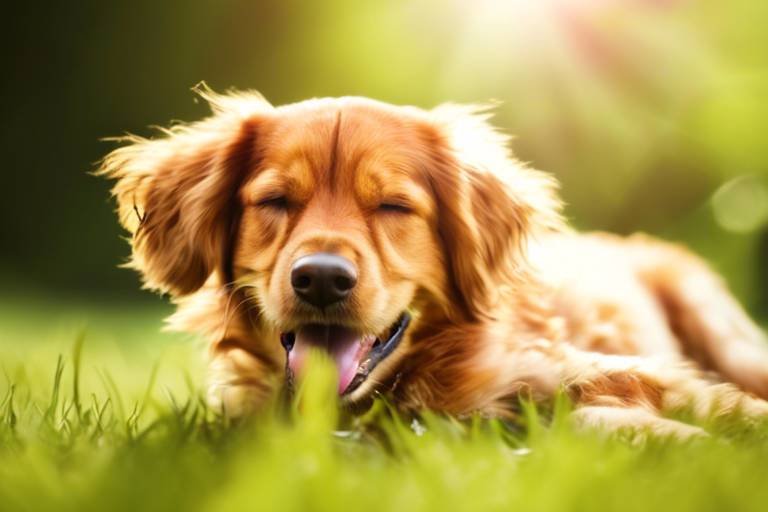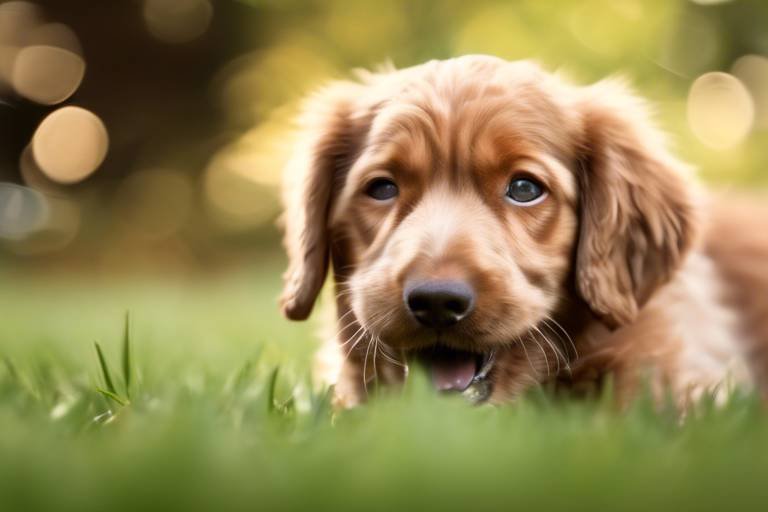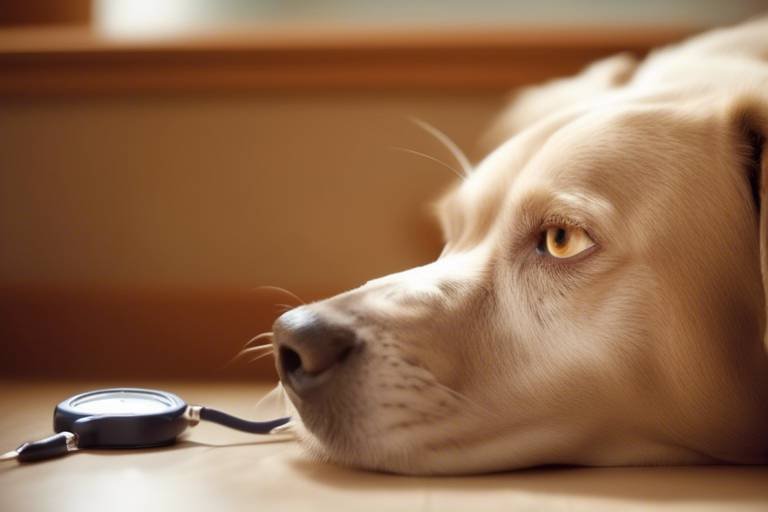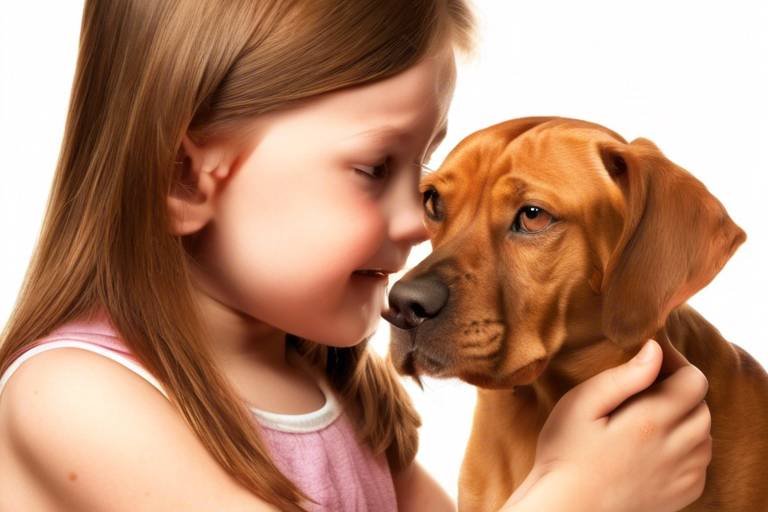What to Do If Your Pet Is Overheated
As the sun blazes down and temperatures soar, our furry friends can find themselves in a bit of a pickle. Just like us, pets can suffer from overheating, and it's up to us to be their guardians. Whether it's a playful pup or a cuddly kitten, understanding how to respond when your pet shows signs of overheating is crucial. Imagine being trapped in a sauna with no way out; that's how your pet feels when they overheat. In this article, we'll explore essential tips and steps to take when you notice your pet is feeling the heat. Remember, being proactive can make all the difference in ensuring their safety and well-being during those sweltering summer days.
Understanding the symptoms of overheating in pets is crucial. Just like we sweat to cool down, pets rely on panting and other signals to let us know they're struggling. Common signs include:
- Excessive panting: If your pet is panting like they've just run a marathon, it's time to take action.
- Drooling: A sudden increase in drool can indicate distress.
- Weakness: If your pet seems wobbly or lethargic, don’t ignore it.
- Disorientation: If they seem confused or unsteady, they may need immediate help.
These signs can escalate quickly, so it’s essential to stay vigilant. Think of it as your pet's way of waving a red flag, signaling that they need your help.
If you suspect your pet is overheated, quick action is essential. The first step is to move them to a cooler area. This could be indoors or under a shaded tree. Next, provide fresh water to help them rehydrate. Remember, just like us, pets can be picky about their water, so make sure it's cool and inviting. You can also use cool, damp cloths to help lower their body temperature. Gently applying these cloths to their paws, neck, and belly can provide immediate relief. Think of it as giving your pet a refreshing spa day!
Keeping your pet hydrated is vital during heat exposure. Always have fresh, cool water available, and encourage your pet to drink regularly to prevent dehydration and overheating. You might even consider adding ice cubes to their water bowl; many pets find this extra chilly treat irresistible!
Be alert for signs of dehydration in pets, which can include:
- Dry gums: If their gums feel tacky or dry, it's a warning sign.
- Lethargy: A sudden drop in energy can indicate dehydration.
- Loss of skin elasticity: Gently pinch the skin on their back; if it doesn’t snap back quickly, they may be dehydrated.
Recognizing these signs can help you act quickly and effectively, ensuring your pet stays safe and healthy.
If your pet is dehydrated, offering electrolyte solutions or ice cubes can help. These methods can be particularly effective in replenishing lost fluids. However, always consult your veterinarian for the best rehydration methods suited for your pet's needs. Just like we wouldn’t want to drink anything harmful, the same goes for our pets!
In some cases, overheating can lead to serious health issues. If your pet exhibits severe symptoms or does not improve quickly, it’s crucial to seek veterinary assistance immediately. Think of it as calling for backup when you’re in a tough spot – it’s better to be safe than sorry!
Preventive measures can significantly reduce the risk of overheating. This includes ensuring adequate shade, avoiding strenuous activities during peak heat, and keeping your pet indoors during extreme temperatures. Just like we wear sunscreen and hats to protect ourselves, our pets need similar care!
Designing a comfortable and cool living space for your pet can help prevent overheating. Consider using fans, air conditioning, or cooling mats to maintain a safe temperature. Think of it as setting up a little oasis for your furry friend, where they can chill out and relax!
When taking your pet outdoors, monitor their activity levels closely. Limit exercise during hot days and schedule walks during cooler times, such as early morning or late evening. Just like you wouldn’t want to run a marathon in the heat, your pet deserves the same level of consideration!
Q: How can I tell if my pet is too hot?
A: Look for signs like excessive panting, drooling, weakness, and disorientation. If you notice these, take action immediately!
Q: What should I do if my pet is overheated?
A: Move them to a cooler area, offer fresh water, and use damp cloths to help lower their temperature.
Q: How can I prevent my pet from overheating?
A: Ensure they have shade, limit exercise during peak heat, and keep them indoors during extreme temperatures.
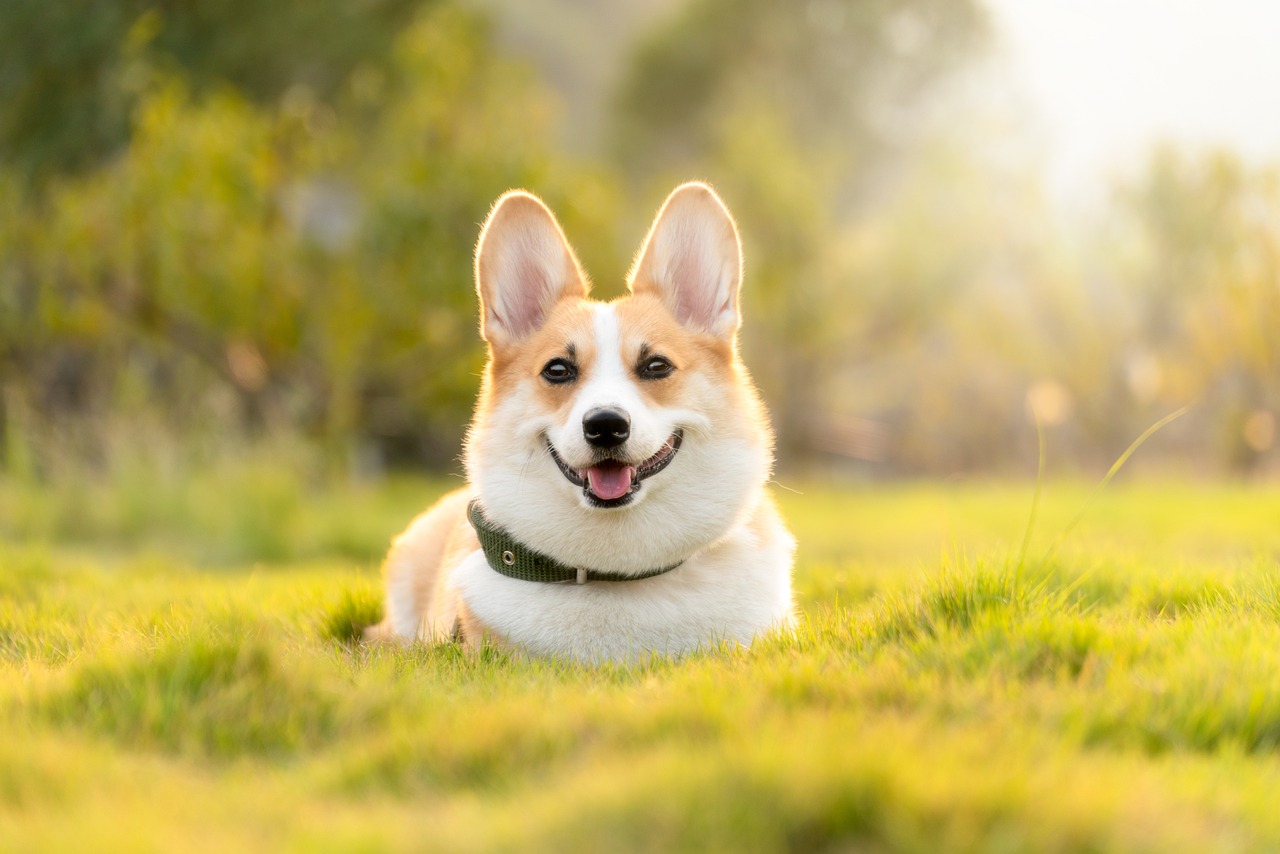
Recognizing Signs of Overheating
This article provides essential tips and steps to take when your pet shows signs of overheating, ensuring their safety and well-being during hot weather conditions.
Understanding the symptoms of overheating in pets is crucial. When the temperature rises, our furry friends can't sweat like we do, making them more vulnerable to heat stress. Common signs of overheating include:
- Excessive Panting: If your pet is panting heavily, it’s a clear signal that they are struggling to cool down.
- Drooling: Increased saliva production can indicate distress and overheating.
- Weakness: If your pet seems unusually lethargic or wobbly, this is a serious warning sign.
- Disorientation: Confusion or stumbling can suggest that your pet is overheating and needs immediate help.
These symptoms can escalate quickly, so it’s essential to act fast. Just like humans, pets can suffer from heat exhaustion, which can lead to heatstroke if not addressed promptly. Imagine running a marathon without water on a scorching day—that's what your pet feels when they overheat!
Additionally, pay attention to the environment. If your pet has been outside on a hot day, particularly in direct sunlight, the risk of overheating increases significantly. Factors such as humidity, age, breed, and pre-existing health conditions can also affect how well your pet tolerates heat. For instance, brachycephalic breeds like Bulldogs and Pugs are particularly susceptible to overheating due to their short snouts, which makes breathing more difficult.
Being vigilant and recognizing these signs early can save your pet from serious health issues. If you notice any of these symptoms, don’t hesitate to take action. Remember, your pet relies on you to keep them safe and comfortable, especially when the mercury rises!
If you suspect your pet is overheated, quick action is essential. Move them to a cooler area, provide fresh water, and use cool, damp cloths to help lower their body temperature.
Keeping your pet hydrated is vital during heat exposure. Always have fresh, cool water available, and encourage your pet to drink regularly to prevent dehydration and overheating.
Be alert for signs of dehydration in pets, which can include dry gums, lethargy, and loss of skin elasticity. Recognizing these signs can help you act quickly.
If your pet is dehydrated, offering electrolyte solutions or ice cubes can help. Always consult your veterinarian for the best rehydration methods suited for your pet's needs.
In some cases, overheating can lead to serious health issues. If your pet exhibits severe symptoms or does not improve quickly, it’s crucial to seek veterinary assistance immediately.
Preventive measures can significantly reduce the risk of overheating. This includes ensuring adequate shade, avoiding strenuous activities during peak heat, and keeping your pet indoors during extreme temperatures.
Designing a comfortable and cool living space for your pet can help prevent overheating. Consider using fans, air conditioning, or cooling mats to maintain a safe temperature.
When taking your pet outdoors, monitor their activity levels closely. Limit exercise during hot days and schedule walks during cooler times, such as early morning or late evening.
Q: What should I do if my pet is overheated?
A: Move your pet to a cooler area, provide fresh water, and use cool, damp cloths to help lower their body temperature. If symptoms persist, seek veterinary help.
Q: How can I tell if my pet is dehydrated?
A: Signs of dehydration include dry gums, lethargy, and loss of skin elasticity. If you notice these signs, offer water or electrolyte solutions.
Q: Are certain breeds more susceptible to overheating?
A: Yes, brachycephalic breeds like Bulldogs and Pugs are particularly vulnerable due to their short snouts, making it harder for them to breathe in hot weather.
Q: What are the long-term effects of overheating?
A: Overheating can lead to serious health issues like heatstroke, organ failure, or even death if not addressed quickly. Always be vigilant in hot weather.
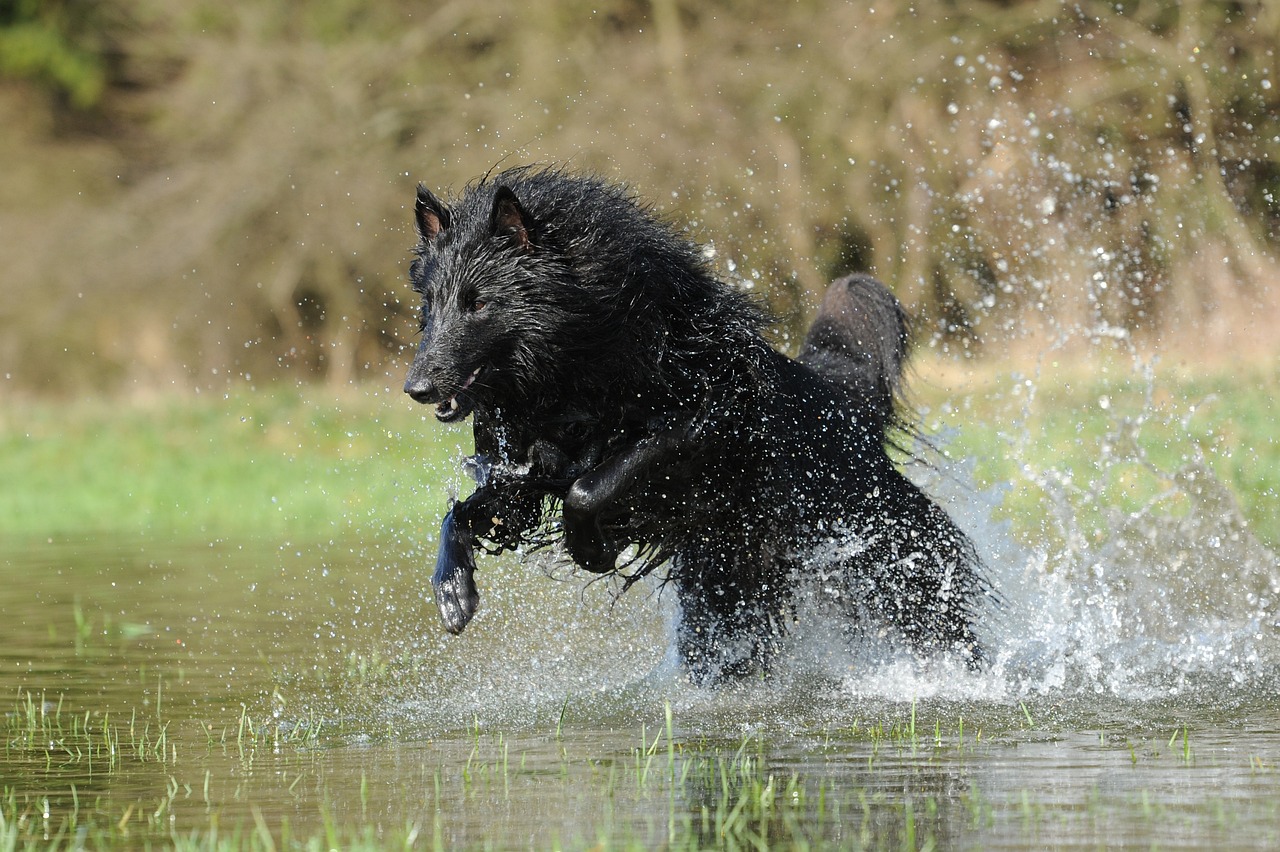
Immediate Actions to Cool Your Pet
When the temperature rises, our furry friends can quickly become overheated, and it's up to us to act swiftly to ensure their comfort and safety. If you suspect your pet is feeling the heat, quick action is essential. First, you should move them to a cooler area—preferably indoors or in the shade, away from direct sunlight. This immediate shift can make a world of difference in their comfort level. Next, offer them fresh, cool water. Hydration is critical, and sometimes just a drink can help revive a lethargic pet. You can even try enticing them with ice cubes to make drinking more appealing.
Another effective method to cool your pet down is to use cool, damp cloths. Gently rub these cloths on their body, focusing on areas where blood vessels are close to the skin, such as the belly, armpits, and groin. This can help lower their body temperature more effectively. However, be cautious not to use ice-cold water, as this can cause shock. Instead, aim for a comfortably cool temperature. If your pet seems to improve after these actions, keep monitoring them closely. If not, it may be time to escalate your response.
Moreover, pay attention to your pet's behavior during this process. If they show signs of distress, such as excessive panting or drooling, it’s important to act fast. You might want to consider using a fan or air conditioning to circulate the air around them, creating a more comfortable environment. Sometimes, a simple change in the atmosphere can help them cool down significantly.
For a quick reference, here’s a simple table summarizing the immediate actions you can take:
| Action | Description |
|---|---|
| Move to a cooler area | Relocate your pet indoors or to a shaded spot. |
| Provide fresh water | Encourage your pet to drink cool water to stay hydrated. |
| Use damp cloths | Apply cool, damp cloths to their body, especially on the belly and groin. |
| Monitor behavior | Keep an eye on your pet’s symptoms and act accordingly. |
In essence, the key is to remain calm and attentive. Your pet looks to you for guidance, and your ability to respond swiftly can make all the difference in their well-being.
- What are the first signs of overheating in pets? Look for excessive panting, drooling, weakness, and disorientation.
- How can I tell if my pet is dehydrated? Signs include dry gums, lethargy, and loss of skin elasticity.
- When should I take my pet to the vet? If your pet shows severe symptoms or does not improve quickly after cooling measures.
- Is it safe to use ice on my pet? Avoid using ice-cold water as it can cause shock; instead, use cool water.
Hydration is Key
This article provides essential tips and steps to take when your pet shows signs of overheating, ensuring their safety and well-being during hot weather conditions.
Understanding the symptoms of overheating in pets is crucial. Common signs include excessive panting, drooling, weakness, and disorientation, which indicate your pet may need immediate attention.
If you suspect your pet is overheated, quick action is essential. Move them to a cooler area, provide fresh water, and use cool, damp cloths to help lower their body temperature.
When it comes to keeping your furry friend safe during those scorching summer days, . Just like us, pets can become dehydrated quickly, and this can lead to serious health issues. Always ensure that your pet has access to fresh, cool water throughout the day. It's not just about having water available; it's also about encouraging your pet to drink regularly. You might be surprised at how many pets will ignore their water bowl if it’s not appealing enough. Consider changing the water frequently to keep it fresh and adding ice cubes on particularly hot days to make it more enticing.
In addition to plain water, you can also offer electrolyte solutions specifically designed for pets. These can be a game-changer, especially after a long walk or play session in the heat. Just like athletes need to replenish their electrolytes, your pet can benefit from these solutions too. If your pet is hesitant to drink, try offering water in a different bowl or even using a pet water fountain, which can encourage them to drink more.
Here’s a quick overview of hydrating options:
| Hydration Method | Description |
|---|---|
| Fresh Water | Always have clean, cool water available for your pet. |
| Electrolyte Solutions | Specially formulated drinks to replenish lost minerals. |
| Ice Cubes | Adding ice cubes to water can make it more appealing. |
Be alert for signs of dehydration in pets, which can include dry gums, lethargy, and loss of skin elasticity. Recognizing these signs can help you act quickly. If you notice that your pet's gums are sticky or dry, or if they seem unusually tired, it’s time to take action. You can perform a simple skin test by gently pinching the skin on the back of their neck; if it doesn’t spring back quickly, your pet may be dehydrated.
If your pet is dehydrated, offering electrolyte solutions or ice cubes can help. Always consult your veterinarian for the best rehydration methods suited for your pet's needs. For instance, if your dog is particularly fussy, you might want to try offering flavored water or broth to entice them to drink. Remember, the goal is to keep your pet hydrated and happy!
In some cases, overheating can lead to serious health issues. If your pet exhibits severe symptoms or does not improve quickly, it’s crucial to seek veterinary assistance immediately.
Preventive measures can significantly reduce the risk of overheating. This includes ensuring adequate shade, avoiding strenuous activities during peak heat, and keeping your pet indoors during extreme temperatures.
Designing a comfortable and cool living space for your pet can help prevent overheating. Consider using fans, air conditioning, or cooling mats to maintain a safe temperature.
When taking your pet outdoors, monitor their activity levels closely. Limit exercise during hot days and schedule walks during cooler times, such as early morning or late evening.
- How can I tell if my pet is overheating? Look for signs like excessive panting, drooling, or lethargy.
- What should I do if my pet is overheated? Move them to a cooler place, offer water, and use cool cloths.
- How often should I give my pet water during hot weather? Encourage them to drink regularly, especially after playtime.
- When should I contact a vet? If symptoms persist or worsen, seek help immediately.
Signs of Dehydration
Recognizing the in your pet is essential for their health and well-being, especially during the sweltering summer months. Just like us, our furry friends can suffer from dehydration, which can lead to serious health issues if not addressed promptly. So, what should you look for? Here are some common indicators:
- Dry Gums: Check your pet's gums; they should be moist and pink. If they feel dry or sticky, it’s a sign of dehydration.
- Lethargy: Is your pet unusually tired or less active? A sudden drop in energy levels can indicate that they are not getting enough fluids.
- Loss of Skin Elasticity: A simple test is to gently pinch the skin on the back of your pet's neck. If it doesn't snap back quickly, your pet may be dehydrated.
- Sunken Eyes: If your pet's eyes appear sunken or dull, it could be a sign that they are dehydrated and need immediate attention.
These signs can sometimes be subtle, so it's important to keep a close eye on your pet, especially during hot weather. Just like a flower wilting without water, your pet's health can decline rapidly without proper hydration. Remember, if you notice any of these signs, it's crucial to act quickly. Hydration can be a game-changer, turning a potentially dangerous situation into a manageable one.
In addition to these signs, you might also observe changes in your pet's behavior. For instance, they may become more irritable or seek out cool surfaces to lie on. This behavior can be a clear signal that their body is struggling to maintain a healthy temperature and hydration level. Always be proactive and keep a watchful eye on your beloved companion.
If you suspect your pet is dehydrated, don’t hesitate to consult your veterinarian. They can provide you with tailored advice and treatment options to ensure your furry friend stays healthy and happy.
Q: How can I prevent my pet from getting dehydrated?
A: Always provide fresh, cool water, especially during hot weather. Ensure your pet has access to shade and consider using cooling mats or fans.
Q: What should I do if my pet is dehydrated?
A: Offer your pet fresh water or an electrolyte solution. If they refuse to drink or show severe signs of dehydration, seek veterinary assistance immediately.
Q: Can certain breeds be more susceptible to overheating?
A: Yes, brachycephalic breeds (like Bulldogs and Pugs) are particularly at risk due to their short snouts, which can hinder their ability to cool down effectively.
Q: How often should I check my pet during hot weather?
A: It's best to check on your pet frequently during hot days, especially if they are active or outside. Pay attention to their behavior and hydration levels.
Rehydration Techniques
When it comes to rehydrating your pet, there are several effective techniques you can employ to ensure they recover from dehydration. First and foremost, offering electrolyte solutions designed specifically for pets can be incredibly beneficial. These solutions help replenish lost minerals and fluids, making them a great choice if your furry friend has been exposed to excessive heat. You can find these solutions at your local pet store or through your veterinarian.
Another simple yet effective method is to provide ice cubes. Many pets enjoy chewing on ice, and it can be a fun way to encourage them to hydrate. Just make sure to supervise them while they enjoy this treat to prevent any choking hazards. Additionally, you can mix ice cubes into their water bowl to keep the water cool and enticing.
It's also important to remember that some pets may be more reluctant to drink water, especially if they are feeling unwell. In such cases, you might consider using a syringe or dropper to gently administer water directly into their mouth. This method can be particularly useful for smaller pets or those who are less cooperative. Just be cautious and ensure that you don't force too much water at once, as this can lead to choking.
For pets that are still hesitant to drink, try offering them wet food or adding water to their dry kibble. This can provide a dual benefit of hydration and nutrition, especially if they are not eating as much as usual. It’s a great way to sneak in some extra moisture without them even realizing it!
Lastly, always consult your veterinarian for tailored advice based on your pet's specific needs. They can recommend the best rehydration techniques and products suited for your pet's age, size, and health condition. Keeping your pet hydrated is vital, especially during those hot summer months, so don’t hesitate to take action!
- How can I tell if my pet is dehydrated? Look for signs such as dry gums, lethargy, and loss of skin elasticity. If you're unsure, it's always best to consult your veterinarian.
- Can I give my pet human electrolyte drinks? No, many human electrolyte drinks contain ingredients that can be harmful to pets. Always use products specifically designed for animals.
- How often should I offer water to my pet during hot weather? It's essential to provide access to fresh water at all times, encouraging them to drink frequently to stay hydrated.
- What should I do if my pet refuses to drink? Try offering different types of water bowls, adding flavor to the water, or using a syringe to help them hydrate.
When to Seek Veterinary Help
If your furry friend shows signs of overheating, it’s essential to act quickly and monitor their condition closely. While some symptoms may be manageable at home, there are specific situations where veterinary intervention is crucial. For instance, if your pet is experiencing severe panting, vomiting, or has lost consciousness, these are clear indicators that you need to seek professional help immediately. Remember, time is of the essence when it comes to overheating!
Additionally, if your pet exhibits any of the following severe symptoms, do not hesitate to contact your veterinarian:
- Severe lethargy: If your pet seems unusually tired or unresponsive, it could indicate a serious condition.
- Rapid heart rate: An elevated heart rate can be a sign of distress and overheating.
- Difficulty breathing: If your pet is struggling to breathe, this is a medical emergency.
- Seizures or tremors: Any neurological symptoms should be addressed immediately.
Even if your pet appears to recover after initial cooling measures, it’s wise to consult with your vet. Some effects of overheating can be delayed, leading to complications such as organ damage or heat stroke. Always err on the side of caution—your pet’s health and safety are paramount.
Q: What should I do if my pet is overheated but seems fine after cooling down?
A: While your pet may seem fine, it’s still advisable to monitor them closely for any delayed symptoms and consult your veterinarian to ensure everything is okay.
Q: Can certain breeds be more susceptible to overheating?
A: Yes, flat-faced breeds like Bulldogs and Pugs are particularly prone to overheating due to their respiratory structure. Always be extra cautious with these breeds during hot weather.
Q: Are there any home remedies for cooling down my pet?
A: Besides providing water, you can use cool, damp cloths on their body, but avoid using ice directly. Always consult your vet before trying any home remedies.
Q: How can I tell if my pet is dehydrated?
A: Look out for dry gums, excessive drooling, and loss of skin elasticity. If you suspect dehydration, offer them water or an electrolyte solution and consult your vet.

Preventing Overheating in Pets
Preventing overheating in pets is not just a good idea; it’s essential for their health and happiness. Just like humans, our furry friends can suffer from heat-related issues, and it’s up to us to ensure they stay cool and comfortable. One of the most effective strategies is to create a shaded area in your yard or home where your pet can escape the sun. Think of it like building a cozy retreat where your pet can chill out during those scorching summer days. Providing plenty of fresh water is also crucial; it’s like giving them a refreshing drink on a hot day. Make sure to refill their water bowl regularly and consider adding ice cubes to keep it cool.
Another important aspect is to monitor your pet's activity levels during hot weather. Just as you wouldn’t run a marathon in the sweltering heat, your pet shouldn’t be overly active when temperatures soar. Try to limit their exercise to cooler parts of the day, such as early morning or late evening. This way, they can enjoy their walks without the risk of overheating. If you notice them panting excessively or slowing down, it’s a clear sign to take a break and find some shade.
Creating a cool environment at home also plays a big role in preventing overheating. Air conditioning is a fantastic option, but if that’s not available, fans can help circulate air and lower the temperature. You can even invest in cooling mats designed specifically for pets. These mats work like magic, providing a cool surface for your pet to lie on. Imagine how refreshing it would feel to lay on a cool surface after being outside in the heat!
Lastly, be proactive about your pet's well-being. Regular grooming can help keep your pet’s coat in check, especially for long-haired breeds. A well-groomed pet is less likely to overheat, as their fur can trap heat. If you’re unsure about how to groom your pet properly, don’t hesitate to ask your veterinarian for tips or even consider professional grooming services. Remember, taking these preventive measures not only helps keep your pet comfortable but also protects them from serious health risks associated with overheating.
- What are the signs of overheating in pets? Look for excessive panting, drooling, weakness, and disorientation.
- How can I cool down my pet quickly? Move them to a cooler area, provide fresh water, and use cool, damp cloths.
- When should I take my pet to the vet? If your pet shows severe symptoms or doesn’t improve quickly, seek veterinary help.
- Can I walk my dog during hot weather? It’s best to walk them during cooler times, like early morning or late evening.
- What should I do if my pet is dehydrated? Offer electrolyte solutions or ice cubes, and consult your veterinarian for advice.
Creating a Cool Environment
This article provides essential tips and steps to take when your pet shows signs of overheating, ensuring their safety and well-being during hot weather conditions.
Understanding the symptoms of overheating in pets is crucial. Common signs include excessive panting, drooling, weakness, and disorientation, which indicate your pet may need immediate attention.
If you suspect your pet is overheated, quick action is essential. Move them to a cooler area, provide fresh water, and use cool, damp cloths to help lower their body temperature.
Keeping your pet hydrated is vital during heat exposure. Always have fresh, cool water available, and encourage your pet to drink regularly to prevent dehydration and overheating.
Be alert for signs of dehydration in pets, which can include dry gums, lethargy, and loss of skin elasticity. Recognizing these signs can help you act quickly.
If your pet is dehydrated, offering electrolyte solutions or ice cubes can help. Always consult your veterinarian for the best rehydration methods suited for your pet's needs.
In some cases, overheating can lead to serious health issues. If your pet exhibits severe symptoms or does not improve quickly, it’s crucial to seek veterinary assistance immediately.
Preventive measures can significantly reduce the risk of overheating. This includes ensuring adequate shade, avoiding strenuous activities during peak heat, and keeping your pet indoors during extreme temperatures.
Designing a comfortable and cool living space for your pet is essential to prevent overheating. Start by ensuring that your home is well-ventilated and shaded. You can use fans or air conditioning to help circulate air and maintain a cooler temperature. Remember, pets can’t sweat like humans do, so they rely on their environment to help regulate their body temperature.
Consider using cooling mats or pet beds that are designed to absorb heat. These products can provide a refreshing spot for your furry friend to relax. Additionally, you might want to create a cozy corner with a damp towel or a shallow pool of water where they can cool off. Always keep an eye on your pet's behavior; if they seem restless or uncomfortable, it might be a sign that they need a cooler environment.
Moreover, if you live in an area that experiences extreme heat, think about adjusting your pet's schedule. For instance, keep them indoors during the hottest parts of the day and allow them to enjoy outdoor time during the cooler mornings or evenings. This simple change can make a world of difference in keeping your pet safe and comfortable.
- What are the signs that my pet is overheating? Look for excessive panting, drooling, weakness, and disorientation.
- How can I cool my pet down quickly? Move them to a cooler area, provide fresh water, and use cool, damp cloths on their body.
- When should I take my pet to the vet? If your pet shows severe symptoms or doesn’t improve quickly after cooling down.
- What can I do to prevent overheating? Ensure your pet has access to shade, avoid strenuous activities during peak heat, and keep them indoors during extreme temperatures.
Monitoring Outdoor Activities
When it comes to keeping your furry friend safe during the hot summer months, is paramount. Just like we humans can overheat, our pets are equally susceptible to the sweltering heat. Imagine taking a long run on a scorching day without a sip of water—it's no different for your pet. To ensure your pet stays cool and comfortable, you need to be vigilant about their outdoor activities.
First and foremost, consider the time of day. The sun is at its peak during the afternoon, making it the hottest part of the day. Scheduling walks and playtime during the cooler hours—like early morning or late evening—can make a world of difference. This not only helps prevent overheating but also allows your pet to enjoy their time outside without the risk of heat exhaustion. Think of it as planning a picnic in the shade rather than under the blazing sun!
While you're outside with your pet, keep an eye on their behavior. If they start to slow down, pant excessively, or seek shade, it’s time to take a break. Recognizing these signs early can prevent a minor issue from escalating into a serious health concern. You might also want to carry a portable water bottle or collapsible bowl to keep your pet hydrated during your outings. Just like a thirsty traveler needs water on a long journey, your pet does too!
Additionally, consider the surfaces your pet walks on. Pavement can become incredibly hot and can burn their paws. To check if the ground is too hot, place your hand on the surface for a few seconds—if it’s uncomfortable for you, it’s likely too hot for your pet. If you're unsure, stick to grassy areas or take your walks on the beach where the sand may be cooler. This way, your pet can enjoy their time outside without risking injury.
Lastly, it’s essential to keep an eye on your pet’s hydration. Just like we need to replenish fluids after sweating, pets need regular access to fresh water. If you're out for an extended period, make sure to stop and offer your pet water frequently. A well-hydrated pet is a happy pet, ready to explore the world around them!
- What are the signs that my pet is overheating?
Common signs include excessive panting, drooling, weakness, and disorientation. - How can I cool down my overheated pet?
Move them to a cooler area, provide fresh water, and use cool, damp cloths on their body. - When should I take my pet to the vet for overheating?
If your pet exhibits severe symptoms or does not improve quickly after cooling measures, seek veterinary assistance immediately. - What preventive measures can I take to avoid overheating?
Ensure adequate shade, avoid strenuous activities during peak heat, and keep your pet indoors during extreme temperatures.
Frequently Asked Questions
- What are the signs that my pet is overheating?
Look out for symptoms like excessive panting, drooling, weakness, and disorientation. If you notice these signs, it’s important to act quickly to cool your pet down.
- What should I do immediately if my pet is overheated?
First, move your pet to a cooler area and provide them with fresh, cool water. You can also apply cool, damp cloths to their body to help lower their temperature.
- How can I tell if my pet is dehydrated?
Signs of dehydration include dry gums, lethargy, and a loss of skin elasticity. If you notice any of these symptoms, it’s essential to take action quickly.
- What are some effective rehydration techniques for pets?
Offering electrolyte solutions can be beneficial, and ice cubes can also entice your pet to hydrate. Always consult with your veterinarian for the best options tailored to your pet's needs.
- When should I seek veterinary help for my overheated pet?
If your pet shows severe symptoms or doesn’t improve after taking cooling measures, it’s crucial to seek veterinary assistance immediately to prevent serious health issues.
- How can I prevent my pet from overheating?
To prevent overheating, ensure your pet has access to shade, avoid strenuous activities during peak heat, and keep them indoors during extreme temperatures.
- What can I do to create a cool environment for my pet?
Consider using fans, air conditioning, or cooling mats to maintain a comfortable temperature. A cool living space can significantly reduce the risk of overheating.
- How should I monitor my pet during outdoor activities in hot weather?
Always keep an eye on your pet's activity levels. Limit exercise during hot days and schedule walks during cooler times, like early morning or late evening.


